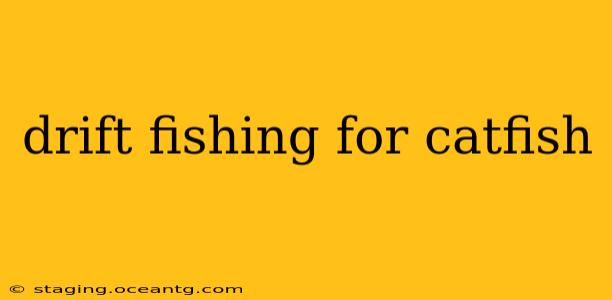Drift fishing for catfish is a rewarding and exciting technique, offering a unique approach to angling for these whiskered giants. Unlike traditional still fishing, drift fishing involves letting your bait drift along the river current, covering more ground and tempting catfish from a wider area. This method is particularly effective in rivers and lakes with a moderate to strong current. This comprehensive guide will cover everything you need to know about successfully drift fishing for catfish.
What is Drift Fishing for Catfish?
Drift fishing, in its simplest form, involves presenting your bait to catfish while allowing the current to carry your boat and line downstream. This natural presentation mimics the movement of baitfish, making it highly appealing to hungry catfish. You're essentially covering a much larger area than you would if you were stationary, increasing your chances of encountering a feeding catfish.
What Gear Do You Need for Drift Fishing Catfish?
Success in drift fishing for catfish relies on having the right equipment. Here's a breakdown of essential gear:
1. The Boat:
A stable boat is crucial, especially in stronger currents. Jon boats, bass boats, and even kayaks can be used, depending on the size of the waterway and the angler's preference.
2. Rod and Reel:
Medium-heavy to heavy-action rods (6.5-7.5 feet long) are ideal for handling the weight of larger catfish and the force of the current. A robust reel with a good drag system is essential to control the fight.
3. Line:
Strong braided line (30-50lb test) provides excellent sensitivity and abrasion resistance. A monofilament leader (15-25lb test) can help prevent line bites.
4. Weights:
Sinker weights (1-4 oz) are used to keep your bait at the desired depth and to control the drift rate. The weight you choose will depend on the current's strength.
5. Hooks:
Circle hooks are highly recommended for drift fishing as they minimize the chances of deep hooking and improve hook-up rates. Sizes 2/0 to 5/0 are suitable depending on the size of bait used.
6. Bait:
Popular catfish baits include live bait (minnows, shad, worms), cut bait (fresh or frozen), and stink baits. Experiment to find what works best in your area.
How to Drift Fish for Catfish: A Step-by-Step Guide
-
Choose your location: Look for areas with moderate to strong currents, drop-offs, river bends, or underwater structures that catfish often frequent.
-
Anchor (Optional): In some instances, using a drift sock or anchor can help control your drift speed and target specific areas more effectively.
-
Rig your line: Attach your weight to the main line, followed by a swivel to prevent line twists. Tie on your leader and hook.
-
Bait your hook: Securely attach your bait to the hook.
-
Cast and drift: Cast upstream and let the current carry your bait downstream. Keep a close eye on your line for bites.
-
Set the hook: When you feel a bite, give the rod a firm sweep to set the hook. Circle hooks often set automatically.
-
Fight the fish: Be prepared for a strong fight, particularly with larger catfish. Use your reel's drag system to control the fight and avoid breaking your line.
What are the Best Times to Drift Fish for Catfish?
The best times for drift fishing for catfish often coincide with periods of low light, such as dawn and dusk, or during nighttime hours. Catfish are often more active and feeding during these times.
What are Some Tips for Successful Drift Fishing for Catfish?
- Vary your drift speed: Experiment with different weights and locations to find the optimal drift speed for attracting catfish.
- Pay attention to water depth: Catfish often prefer deeper water, especially during the day.
- Use scent attractants: Catfish are attracted to scent, so consider using scent attractants to enhance your bait's appeal.
- Be patient: Drift fishing can require patience, but the rewards are well worth the wait.
What are the Different Types of Catfish You Can Catch Drift Fishing?
The type of catfish you can catch while drift fishing will depend on your location. Common species caught using this method include channel catfish, blue catfish, flathead catfish, and bullheads.
How Deep Should My Bait Be While Drift Fishing for Catfish?
The ideal depth for your bait will vary depending on the water's depth and structure. Generally, it's advisable to keep your bait close to the bottom, where catfish tend to feed.
What are the Legal Limits and Regulations for Catfish in My Area?
Fishing regulations vary widely by location. Before you go fishing, it is crucial to check your local regulations regarding size and catch limits for catfish in your area. Contact your state’s wildlife agency or local fisheries department for more details.
By following these tips and techniques, you'll be well on your way to enjoying successful drift fishing adventures for catfish. Remember to always practice responsible angling and adhere to local fishing regulations. Happy fishing!
